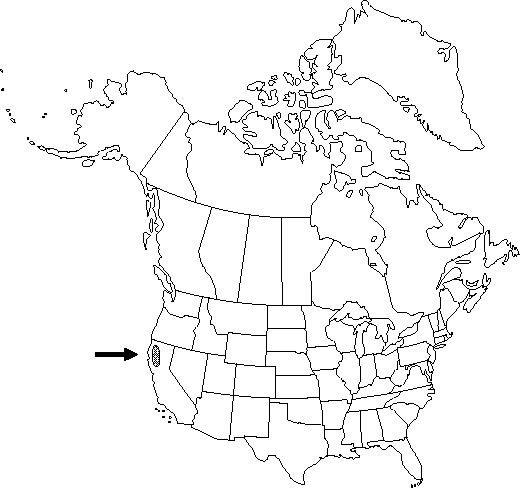Difference between revisions of "Delphinium decorum subsp. tracyi"
Univ. Colorado Stud., Ser. D, Phys. Sci. 2: 100. 1945.
FNA>Volume Importer |
imported>Volume Importer |
||
| (7 intermediate revisions by 2 users not shown) | |||
| Line 21: | Line 21: | ||
}}<!-- | }}<!-- | ||
| − | --><span class="statement" id="st- | + | --><span class="statement" id="st-undefined" data-properties=""><b>Stems </b>7-20(-45) cm. <b>Leaves</b>: ultimate lobes 5-15, usually more than 5 lobes longer than 1/2 leaf radius, apical lobes pronounced. <b>Inflorescences</b> glabrous or nearly so. <b>Flowers</b>: lateral sepals 11-18 mm, spurs 13-20 mm; lower petal hairs white. <b>2n</b> = 16.</span><!-- |
-->{{Treatment/Body | -->{{Treatment/Body | ||
| Line 28: | Line 28: | ||
|elevation=700-2300 m | |elevation=700-2300 m | ||
|distribution=Calif. | |distribution=Calif. | ||
| − | |discussion=<p>Although Delphinium decorum subsp. tracyi probably occurs in southern Oregon, no specimens have been seen from that state. Habitat appears to be the main isolating mechanism between D. decorum subsp. tracyi and D. antoninum; hybrids do occur. The subspecies also hybridizes with D. nudicaule and D. trolliifolium.</p><!-- | + | |discussion=<p>Although <i>Delphinium decorum </i>subsp.<i> tracyi</i> probably occurs in southern Oregon, no specimens have been seen from that state. Habitat appears to be the main isolating mechanism between <i>D. decorum </i>subsp.<i> tracyi</i> and <i>D. antoninum</i>; hybrids do occur. The subspecies also hybridizes with <i>D. nudicaule</i> and <i>D. trolliifolium</i>.</p><!-- |
| − | --><p>Delphinium decorum subsp. tracyi may be confused with D. antoninum or D. nuttallianum. For distinctions from the former, see discussion under that species. Distinctions between D. decorum subsp. tracyi and D. nuttallianum may be made on basis of spreading, fading, bluish purple sepals of the former as opposed to reflexed, colorfast, dark blue to white sepals of the latter. Pubescence of the proximal portion of stems and larger lower petal blades of subsp. tracyi are also useful to distinguish from usually glabrous stems and smaller lower petal blades of D. nuttallianum.</p> | + | --><p><i>Delphinium decorum </i>subsp.<i> tracyi</i> may be confused with <i>D. antoninum</i> or <i>D. nuttallianum</i>. For distinctions from the former, see discussion under that species. Distinctions between <i>D. decorum </i>subsp.<i> tracyi</i> and <i>D. nuttallianum</i> may be made on basis of spreading, fading, bluish purple sepals of the former as opposed to reflexed, colorfast, dark blue to white sepals of the latter. Pubescence of the proximal portion of stems and larger lower petal blades of <i></i>subsp.<i> tracyi</i> are also useful to distinguish from usually glabrous stems and smaller lower petal blades of <i>D. nuttallianum</i>.</p> |
|tables= | |tables= | ||
|references= | |references= | ||
| Line 38: | Line 38: | ||
-->{{#Taxon: | -->{{#Taxon: | ||
name=Delphinium decorum subsp. tracyi | name=Delphinium decorum subsp. tracyi | ||
| − | |||
|authority=Ewan | |authority=Ewan | ||
|rank=subspecies | |rank=subspecies | ||
| Line 53: | Line 52: | ||
|publication year=1945 | |publication year=1945 | ||
|special status=Endemic | |special status=Endemic | ||
| − | |source xml=https:// | + | |source xml=https://bitbucket.org/aafc-mbb/fna-data-curation/src/2e0870ddd59836b60bcf96646a41e87ea5a5943a/coarse_grained_fna_xml/V3/V3_657.xml |
|genus=Delphinium | |genus=Delphinium | ||
|section=Delphinium sect. Diedropetala | |section=Delphinium sect. Diedropetala | ||
| Line 59: | Line 58: | ||
|species=Delphinium decorum | |species=Delphinium decorum | ||
|subspecies=Delphinium decorum subsp. tracyi | |subspecies=Delphinium decorum subsp. tracyi | ||
| − | |||
| − | |||
| − | |||
| − | |||
| − | |||
| − | |||
| − | |||
| − | |||
| − | |||
| − | |||
}}<!-- | }}<!-- | ||
-->[[Category:Treatment]][[Category:Delphinium decorum]] | -->[[Category:Treatment]][[Category:Delphinium decorum]] | ||
Latest revision as of 21:50, 5 November 2020
Stems 7-20(-45) cm. Leaves: ultimate lobes 5-15, usually more than 5 lobes longer than 1/2 leaf radius, apical lobes pronounced. Inflorescences glabrous or nearly so. Flowers: lateral sepals 11-18 mm, spurs 13-20 mm; lower petal hairs white. 2n = 16.
Phenology: Flowering mid-late spring.
Habitat: Meadows in montane forests
Elevation: 700-2300 m
Discussion
Although Delphinium decorum subsp. tracyi probably occurs in southern Oregon, no specimens have been seen from that state. Habitat appears to be the main isolating mechanism between D. decorum subsp. tracyi and D. antoninum; hybrids do occur. The subspecies also hybridizes with D. nudicaule and D. trolliifolium.
Delphinium decorum subsp. tracyi may be confused with D. antoninum or D. nuttallianum. For distinctions from the former, see discussion under that species. Distinctions between D. decorum subsp. tracyi and D. nuttallianum may be made on basis of spreading, fading, bluish purple sepals of the former as opposed to reflexed, colorfast, dark blue to white sepals of the latter. Pubescence of the proximal portion of stems and larger lower petal blades of subsp. tracyi are also useful to distinguish from usually glabrous stems and smaller lower petal blades of D. nuttallianum.
Selected References
None.
